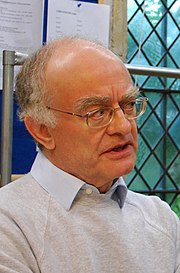Requiem (Rutter)
| Requiem | |
|---|---|
| Sacred vocal music by John Rutter | |

The composer in 2012
|
|
| Text |
|
| Language |
|
| Performed | 13 October 1985: Dallas, Texas |
| Published | 1986: Oxford University Press |
| Movements | 7 |
John Rutter's Requiem is a musical setting of parts of the Latin Requiem with added psalms and biblical verses in English, completed in 1985. It is scored for soprano, mixed choir and orchestra or chamber ensemble.
Five of its seven movements are based on text from the Latin Requiem Mass, while the second movement is a setting of "Out of the deep" (Psalm 130) and the sixth movement is an anthem The Lord is my Shepherd (Psalm 23) which Rutter had earlier written. The first movement combines the Introit and Kyrie, the third is Pie Jesu, with soprano solo. The central movement is a lively Sanctus, followed by Agnus Dei and finally Lux aeterna. In the Agnus Dei and Lux aeterna, Rutter combines the liturgical Latin text with English biblical verses.
Four of the movements of the Requiem were first performed at Fremont Presbyterian Church, Sacramento, California, on 14 March 1985. The first performance of the complete work was at Lovers' Lane United Methodist Church, Dallas, Texas, on 13 October 1985. It was published in 1986 by Oxford University Press
Rutter completed his Requiem in 1985. It bears the dedication "in memoriam L. F. R.".
He conducted the first performance on 13 October 1985 at Lovers' Lane United Methodist Church, Dallas, Texas, where the director of Music Allen Pote) prepared the Sanctuary Choir and orchestra. Movements 1, 2, 4, and 7 were already performed on 14 March 1985 at Fremont Presbyterian Church, Sacramento, California, by the Sanctuary Choir and ensemble, prepared by Mel Olson and also conducted by the composer.
The Requiem was published in 1986 by Oxford University Press, with a singable English text also for the Latin passages.
Rutter scored the Requiem for mixed choir and orchestra. It features solos for cello, soprano and oboe. He prepared two versions, one for a chamber ensemble and one for orchestra. The ensemble consists of flute, oboe, timpani, glockenspiel, harp, cello and organ, while the orchestra has 2 flutes, oboe, 2 clarinets, bassoon, 2 horns, timpani, glockenspiel, harp and strings.
...
Wikipedia
